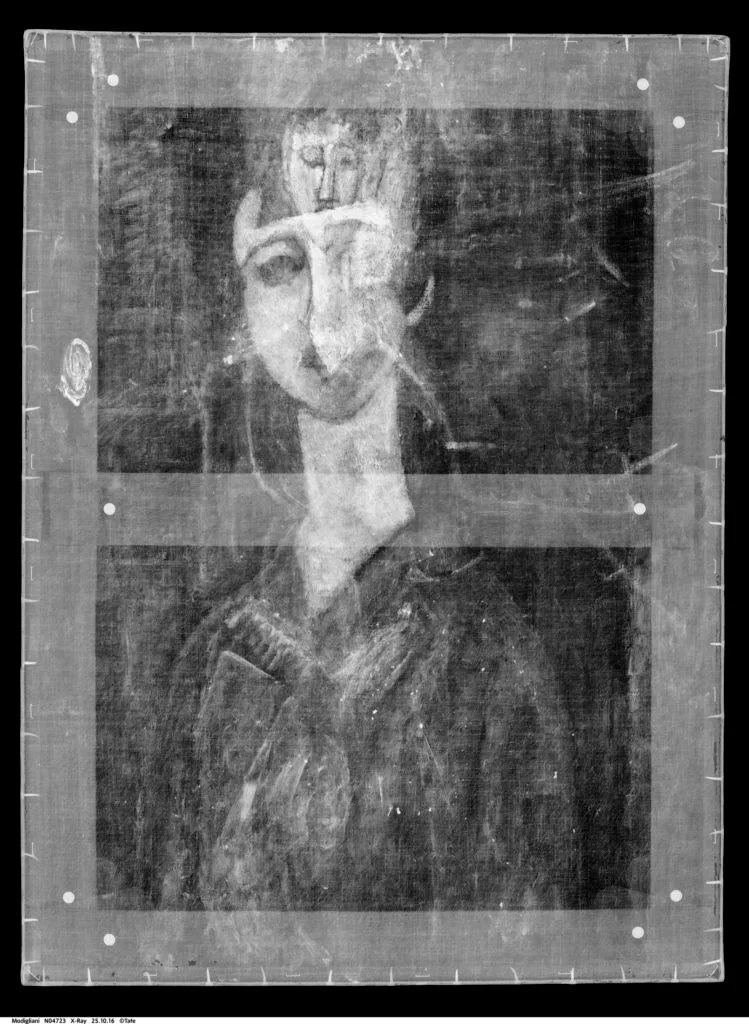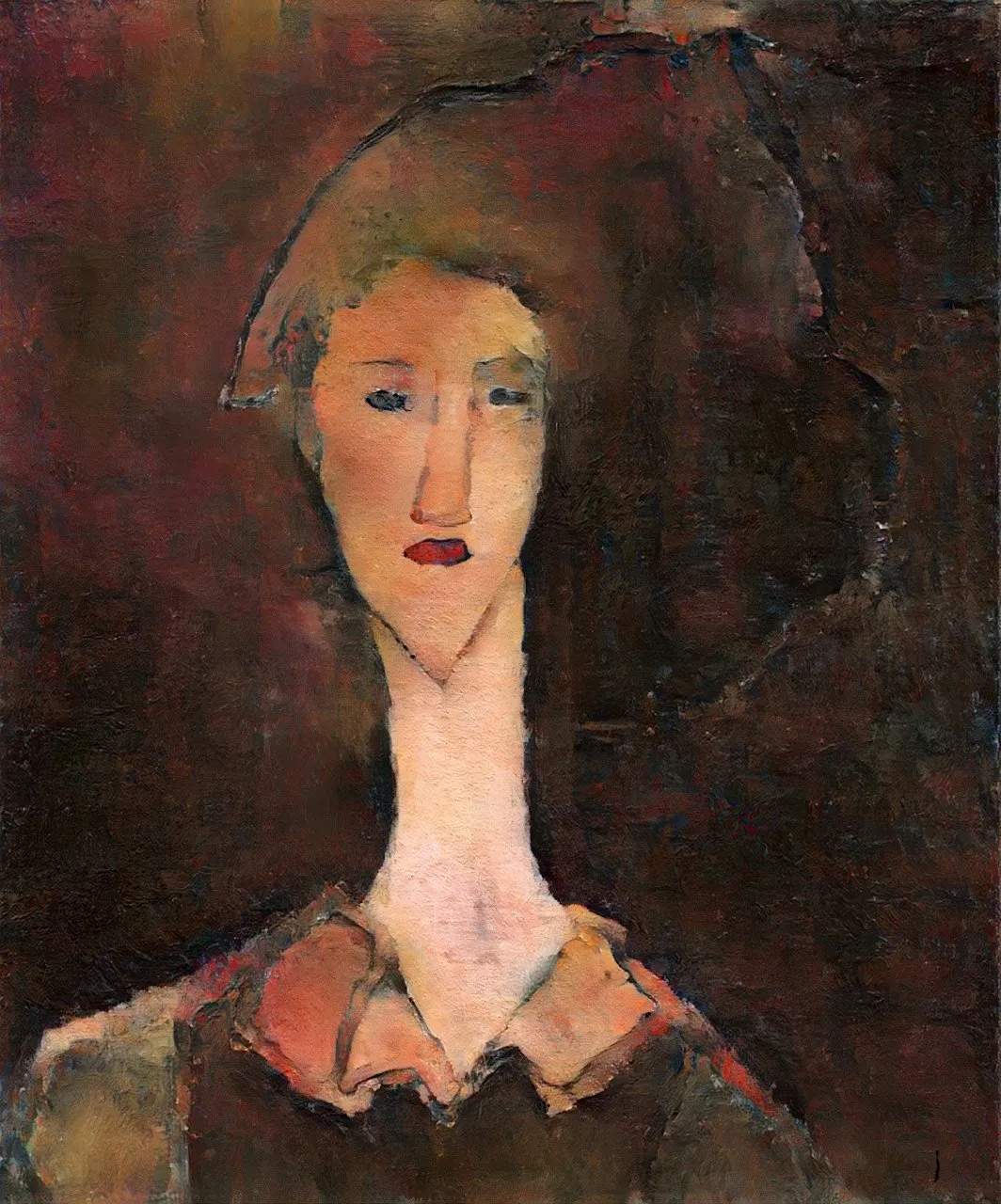Did Modernist Master Modigliani Paint a New Portrait Over a Likeness of His Ex?
A.I. reconstruction reveals hidden image that may depict the Italian artist’s former girlfriend, Beatrice Hastings
:focal(456x481:457x482)/https://tf-cmsv2-smithsonianmag-media.s3.amazonaws.com/filer/08/b7/08b7c82a-44e3-47e6-bcde-5febcbce6b5d/high_res_neomaster.jpeg)
Thanks to artificial intelligence (A.I.), art lovers can now see a “lost” Amedeo Modigliani portrait as it may have originally appeared, reports Dalya Alberge for the Observer.
Earlier this year, Anthony Bourached and George Cann, two PhD candidates at University College London, used A.I. to reconstruct a hidden image of a woman beneath the Italian artist’s Portrait of a Girl (1917).
The painting—a somber image of a dark-haired woman sitting in front of a door—made headlines in early 2018, when curators X-rayed it ahead of a major retrospective at Tate Modern in London.
To their surprise, the researchers discovered the ghostly traces of a totally different full-length female portrait. As Kate Brown reported for Artnet News at the time, some curators suspect that the hidden image depicts Beatrice Hastings, an English writer and journalist who dated Modigliani for two turbulent years. The couple’s relationship ended in 1916—a fact that may have led the artist to literally paint his ex-lover out of the picture.
More than a century after Modigliani covered it up, Bourached and Cann trained an algorithm to simulate what the original portrait might have looked like. A 3-D-printed physical rendering of their creation, complete with computer-simulated “brushstrokes” and texture, will soon go on display at London’s Lebenson Gallery as part of the duo’s “NeoMasters” project.
Per a statement, the pair, who go collectively by Oxia Palus, will also sell 64 copies of the work online—“one to commemorate each year of Beatrice’s life.” (Hastings died by suicide in 1943.)
Born Emily Alice Haigh in 1879, “Hastings” was one of 15 pen names employed by the writer during her career, according to the Kenyon Review. The High Museum of Art notes that she met Modigliani after moving to Paris in 1914 and served as his muse for at least 14 portraits.
Art historian Kenneth Wayne tells the Observer that Hastings and Modigliani were romantically involved at a time when the painter was developing his signature style of highly stylized, surreal figures “with elongated faces and necks and the influence of African art.”
The scholar adds, “Visually, [Hastings] may have influenced him.”
At the same time, Wayne emphasizes, he has yet to be convinced of the sitter’s identity: “I do not immediately recognize her, and I am not sure yet what we can conclude from the X-ray.”
Alternatively, Modigliani could have painted over his portrait for a simpler reason: namely, a lack of funds. Plagued by alcoholism and ill health, the painter struggled to make ends meet, and in 1920, he died penniless of tuberculosis at just 35 years old. As Doug Stewart wrote for Smithsonian magazine in 2005, a landlord once used some of Modigliani’s paintings—offered in lieu of rent—to patch an old mattress.
Today, the artist’s eerie, elongated portraits and frank depictions of nude women sell for as much as $157 million. This sharp rise in demand has led to an “epidemic” of Modigliani forgeries, as Milton Esterow observed for Vanity Fair in 2017.
In 2018, for example, all but 1 of 21 paintings displayed at a major Modigliani show in Genoa, Italy, were revealed to be fakes and handed over to authorities, as Nick Squires reported for the Telegraph at the time.
/https://tf-cmsv2-smithsonianmag-media.s3.amazonaws.com/filer/ab/44/ab44d72e-1fa9-4d43-b486-2fd69816e16c/final_parc_de_labyrinth_de_horta_cropped_11_dec_2020.jpeg)
Like Modigliani, young Pablo Picasso was often strapped for cash. Oxia Palus recently undertook a similar recreation of a painting hidden beneath one of the Cubist artist’s works: The Crouching Beggar (1902). Picasso reused materials by painting over a landscape possibly made by one of his contemporaries, Spanish artist Santiago Rusiñol.
Oxia Palus used A.I. to generate what the landscape might have looked like, down to the color palette and texture of each brushstroke. The team then 3-D printed 100 copies of the painting to sell both as physical items and non-fungible tokens (NFTs), or digital files certifying artworks’ authenticity.
Cann tells the Observer that he and Bourached plan to continue their work with other similarly “hidden” masterpieces.
“There are potentially thousands of artworks out there that are hidden beneath layers of paint,” Cann says. “In the next few years, we’ll be able to bring a light into this darkened gallery.”
Oxia Palus’ recreated Modigliani portrait will be on view at the Lebenson Gallery in London from June 10 to June 25.
/https://tf-cmsv2-smithsonianmag-media.s3.amazonaws.com/accounts/headshot/nora.png)

/https://tf-cmsv2-smithsonianmag-media.s3.amazonaws.com/filer/77/af/77af7c1b-8933-45cc-b8f8-b6d521aadf30/n04723_10.jpeg)

/https://tf-cmsv2-smithsonianmag-media.s3.amazonaws.com/accounts/headshot/nora.png)